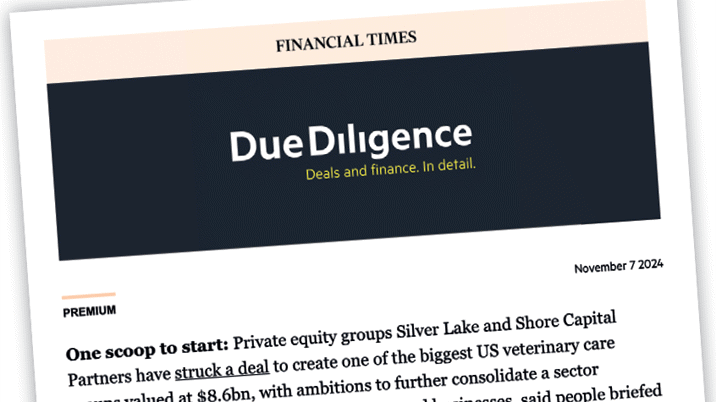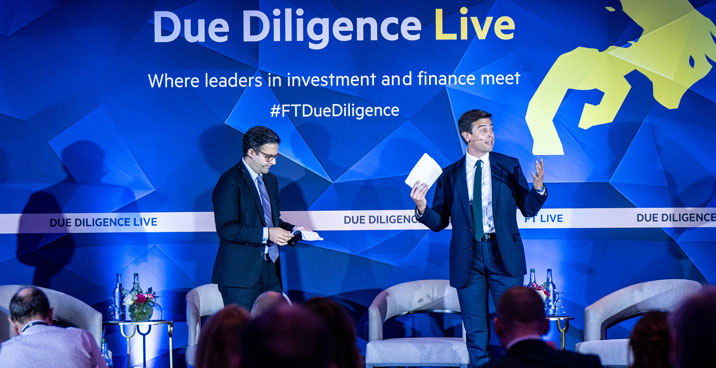
With a near-constant flow of deals and emerging stories on the corporate finance beat, James Fontanella-Khan and Arash Massoudi — the FT’s M&A correspondents in 2017 — felt the sector lacked a singular destination for smart, comprehensive coverage that they looked forward to reading. Meanwhile, as the FT explored how to enhance offerings in its Premium subscription tier that year, Fontanella-Khan and Massoudi spotted an opportunity. Working together with co-workers in the commercial side of the business, they created a plan to deliver readers a resource that would explain the forces shaping the day’s business landscape and offer an inside look into the fast-paced world of dealmaking, money and power. The result was the Due Diligence newsletter.
“Arash and I figured this was a great opportunity to bundle all of our deals and corporate finance coverage in one place to showcase and help our readers find all the great work being done by our colleagues around the world and us,” Fontanella-Khan said. “We felt that building a specialised ‘vertical’ via a newsletter was the best way to achieve this. At the time, newsletters weren’t as popular as they are today. In many ways, they were considered a ‘lesser product’ compared to print. Arash and I thought the opposite.”
Launch
Due Diligence, launched in March 2017, offers FT Premium subscribers the top stories from the world of corporate finance and private equity, including detailed analysis of the dealmakers driving the news. In addition to being a time-saving resource for busy professionals, Fontanella-Khan and Massoudi wanted to leverage the power of the FT network and its reporters’ well-connected sources. In its very first issue, the team provided insight into three of the industry’s top stories at the time: the explosion of US M&A in Europe, the rise of shareholder angst amid litigation challenges, and the future of the Chinese conglomerate Fosun after the departure of its CEO. The comprehensive coverage, conversational style, and expert analysis immediately resonated with readers, and laid the foundation for the loyal and growing audience we have today.
Other early editions of the newsletter showed how Due Diligence connected the dots for readers, and explained what disparate stories from around the paper meant for corporate finance and M&A more broadly. For example, in April 2017, the newsletter highlighted a report on the deal of a lifetime for a French former M&A banker: then-presidential hopeful Emmanuel Macron. Due Diligence reporters tapped their networks to dig into Macron’s time as an investment banker and forecast what his own experiences meant for the future of French M&A. With its unique insight and insider perspective, it was classic ‘DD’ as the newsletter came to be known within the FT and among its readers. Reader feedback has echoed this sentiment: “The newsletter is packed with relevant and up-to-date information. Whether it’s stock market analysis, economic indicators, or global financial news, the content is always fresh and informative. The timely updates ensure that I am never out of the loop on important developments,” one reader told us through a survey we launched in 2022.
Growth
Seven years on, Due Diligence has about 45,000 subscribers, at least a quarter of whom are senior managers or C-level executives. Not only is the newsletter indispensable to its readers, but it has received industry-wide recognition too. Due Diligence this year was selected as the winner of the Newsletter Publisher Awards’ Best B2B newsletter after being put on the shortlist in 2023. It also won the SABEW Best Newsletter award in 2019. And the loyalty of our readers is evident in our data. Due Diligence has an average open rate that is well above industry standards. It was also one of our fastest growing newsletters in 2024. Further, it is among the FT newsletters that drive the most traffic to FT.com on a monthly basis. Due Diligence is one of our most effective newsletters on this measure, driving tens of thousands of clicks to FT.com each month. Our readers know they’ll find scoops and agenda-setting news in the ‘One thing to start’ section and must-read stories in ‘Smart reads’.
As a newsletter that is exclusive to readers in our Premium product tier, the team is committed to adding value to readers’ FT subscription. Due Diligence accomplishes this with its own, distinct voice. The newsletter format gives our reporters the flexibility to speak directly to readers in a way that is much more conversational than traditional stories in print or on FT.com. While delivering news that is impartial and informative, Due Diligence reporters also seek to drive reader engagement and make M&A news entertaining too. “Think: your smartest and most well-connected friend explaining the latest deals and corporate sagas to you over a few pints at the pub,” said Fontanella-Khan. The feedback we get from our readers proves that our approach is working. “I love the punchy writing style and story selection. A very efficient means to have a feeling of your finger on the pulse of deal-making,” one shared with us.
Reader engagement
In Due Diligence, reader engagement is very much a two-way street. Recently, we’ve made fresh efforts to deepen the conversation between our readers and DD reporters. With tens of thousands of industry executives on our mailing list, we recognise the depth of knowledge and experience that our readers maintain, and we know our subscribers can help us create a better product. For example, popular editions have included newsletters in which we feature readers’ views on a given topic. After the team wrote about how the talent wars between US and UK law firms had created a significant jump in junior lawyers’ salaries, we featured a variety of views, from both sides of the Atlantic, in a following edition of the newsletter. In another email, readers sounded off on what GameStop should do with its $4bn cash haul. We have also made updates to the format, like adding a bulleted summary section at the top of the newsletter, based on feedback from readers. Ultimately, we want to create a newsletter for our readers and often, they are best placed to tell us what works — or doesn’t.
Subscriber get-togethers
A large part of the success of Due Diligence has been its commercial strategy. As a ‘mini-brand’, a designation the FT gives to editorial initiatives that engage a core community through formats from newsletters to video to digital hubs and live events, Due Diligence reporters and the wider newsletter team work closely with the business-side of the FT to create a cohesive brand. Since 2020, we have brought the newsletter to life through the annual Due Diligence Live conference. With support from the FT’s events arm, we offer readers access to FT reporters and some of the biggest names in M&A, private equity and corporate finance. The conference brings together hundreds of Due Diligence subscribers while also allowing us to grow our audience.
When it comes to the brand as a whole, we measure engagement with ‘repeat visits’ — any visit by a user to Due Diligence content after their initial visit. In the last six months there has been a 12 per cent increase in visits to Due Diligence compared to the previous period. We’ve also seen a 20 per cent increase in average repeat visits per user. These trends prove how the newsletter plays an essential role in engaging and retaining FT readers.
The success of Due Diligence has even inspired offshoots within the FT. In 2020, we launched Scoreboard, our newsletter on the business of sport, as a weekend offering of Due Diligence. Amid the rise of dealmaking in the sports industry, Scoreboard found a natural audience, at first with the same readers who came to Due Diligence for our comprehensive deals coverage, and later among its own unique audience. The Scoreboard newsletter was so successful that we’ve spun it out into its own ‘mini-brand’.
New markets
We are continually finding new audiences for Due Diligence. Covering deals in such a wide variety of sectors — from telecoms to media, consumer goods, industrials, pharmaceuticals and much more — means that we’re always expanding into new areas. This is also true in a geographic sense. Readers from India have recently accounted for a growing share of pageviews to Due Diligence online. After discovering this trend, we worked with the marketing team to promote the newsletter specifically to readers in the region. We’re also planning future collaborations with our reporters in India to appeal to these new readers, as well as growth opportunities in our well-established markets in the US and Europe.
“We want to consolidate our leadership position in the UK and Europe, grow our presence on Wall Street, and ultimately expand in India, where we are starting to build a dedicated following,” Fontanella-Khan said.
An essential part of Due Diligence’s success is the dedicated team that works on the product. There are now more than 10 reporters that regularly contribute to the newsletter including Amelia Pollard, reporter and producer for Due Diligence and newsletter editor Benjamin Wilhelm. Every Monday to Thursday, Amelia works with the wider team to commission stories for the newsletter, curate stories, write items and make sure the newsletter stays true to its voice. Ben, meanwhile, has his finger on the pulse of DD’s performance, monitoring metrics as well as editing daily copy.
“Producing DD is a team sport, and when you leverage all the human capital present at the FT, from Tokyo to San Francisco, you can really create something unique and special. We’ve also successfully built a DD way of doing things that is based on hyper-collaboration across regions, beats, and departments, which has made us more than the sum of the parts. We do what we do while having fun and without taking ourselves too seriously. The readers, we know, appreciate it,” Fontanella-Khan said.

This article was first published in InPublishing magazine. If you would like to be added to the free mailing list to receive the magazine, please register here.












